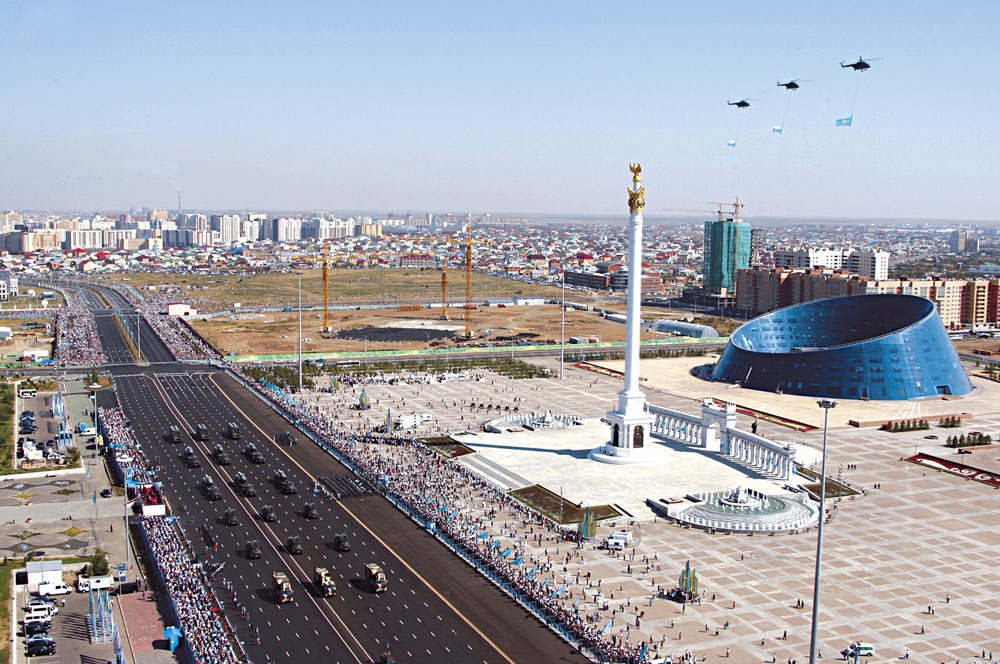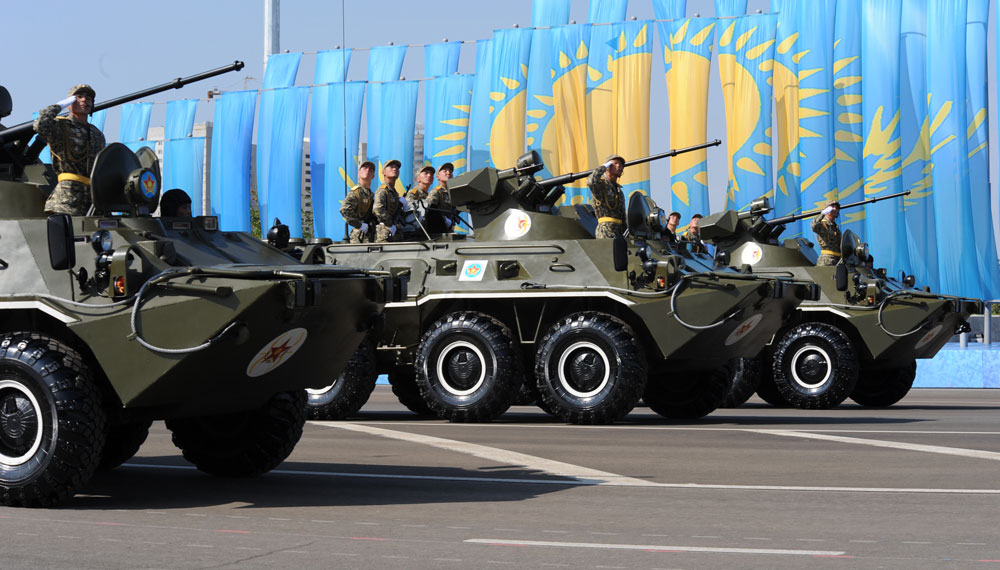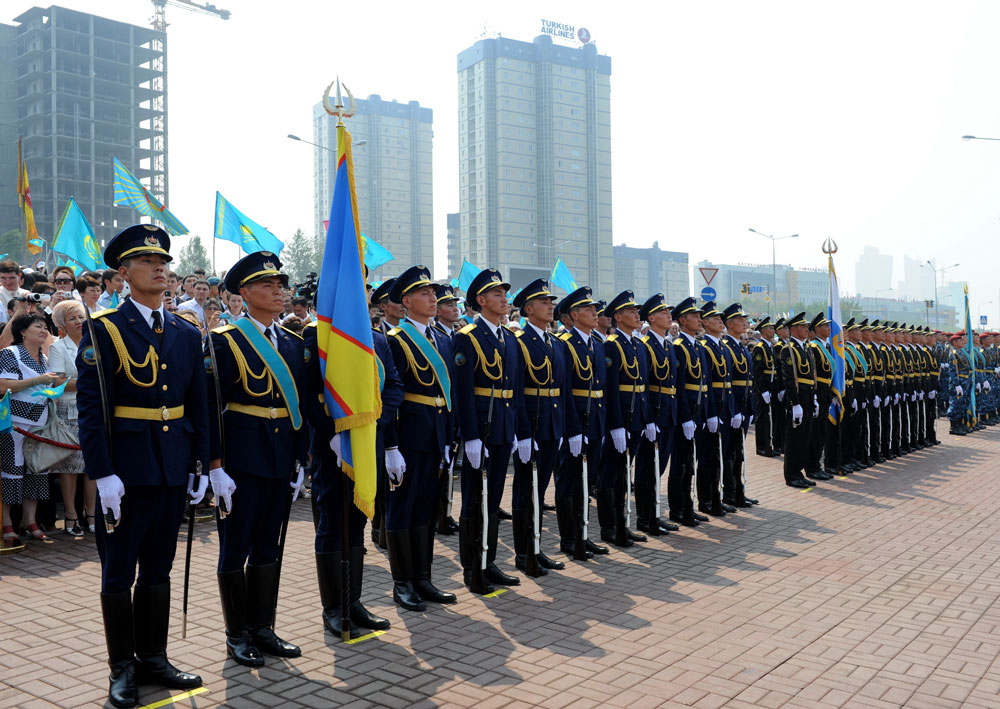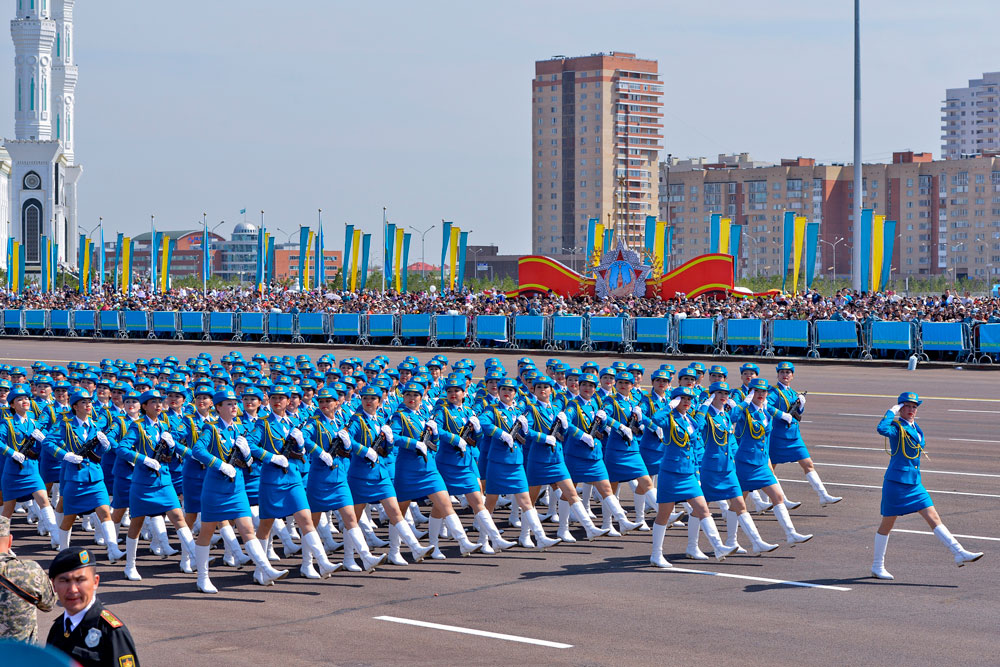
After the August events of 1991, the state of the Armed Forces was critical. The headquarters of the 40th Army was liquidated, which led to chaos in the management of ground forces on the territory of the republic. In 1992, thousands of servicemen illegally left parts of the Ministry of Defense. Budgetary underfunding, problems related to the payment of cash, an outflow of officers to other CIS countries, evasion of military service - all these negative events discredited the army and its cadres. The polygons such as Baikonur, Saryshagan, and Semipalatinsk nuclear center were especially affected. These strategic facilities were practically plundered and decayed. Therefore, the creation of the Armed Forces of Kazakhstan was a logical and objective step of the country's leadership. In the difficult conditions of 1991-1992, in the interests of national security, Kazakhstan defended the idea of forming the Armed Forces of the Commonwealth.
"During the last year of the existence of the USSR and the first years of the formation of the CIS and independent states, the reform of the security structures and the Armed Forces was to some extent spontaneous in nature, it remained the result of a clash of many political interests rather than a purposeful creative process,"
wrote in his memoirs the Hero of the Soviet Union, General Sagadat Kozhakhmetovich Nurmagambetov.

March 16, 1992, in accordance with the Constitutional Law of the Republic of Kazakhstan "On State Independence of the Republic of Kazakhstan", a decree was signed on the establishment of the Republican Guard of the Republic of Kazakhstan.
On the Establishment of the Republican Guard of the Republic of Kazakhstan
Decree of the President of the Republic of Kazakhstan No. 673 of March 16, 1992
In accordance with the Constitutional Law of the Republic of Kazakhstan "On State Independence of the Republic of Kazakhstan" I hereby resolve:
1. To establish the Republican Guard of the Republic of Kazakhstan in order to ensure sovereignty, protect constitutional rights and freedoms of citizens, as well as other vital interests of the Republic of Kazakhstan.
2. To establish that the Republican Guard of the Republic of Kazakhstan is a separate military formation and reserve of the Armed Forces. The Republican Guard submits to the President of the Republic of Kazakhstan, the immediate leadership is entrusted to the Commander of the Republican Guard.
3. The recruitment of the Republican Guard is carried out in accordance with the current legislation on a voluntary basis from among the citizens liable for military service of the Republic of Kazakhstan.
4. The Cabinet of Ministers of the Republic of Kazakhstan: to develop and submit for approval by April 15, 1992 the Regulations on the Republican Guard of the Republic of Kazakhstan, proposals on its structure and states; provide financing, supply with special and military equipment, armament, communications and other property; to determine the procedure for providing housing and creating other social and living conditions for the personnel of the Republican Guard.
President of the Republic of Kazakhstan N. NAZARBAYEV
In May 1992, its formation began. The Republican Guard was entrusted with such tasks as participation in ensuring the security of protected individuals, performing ceremonial rituals, protecting especially important state facilities, protecting the standards of the National Flag of the Republic of Kazakhstan and the State Emblem of the Republic of Kazakhstan.
In different years, the command of the Republican Guard was carried out by Major-General Tulegen Umbetbayev, Colonel-General Sat Tokpakbayev, Major-General Bulat Janasayev, Major-General Bolat Iskakov, Lieutenant-General Abay Tasbulatov, and Lieutenant-General Amangeldy Shabdarbayev.

Relying on the legitimate right to establish its own Armed Forces, confirmed in the agreement of the Council of Heads of State of the CIS member states on the Armed Forces and border troops, on May 7, 1992, the President signed a decree on the creation of the Armed Forces of the Republic of Kazakhstan.
ON THE CREATION OF THE ARMED FORCES OF THE REPUBLIC OF KAZAKHSTAN
Decree of the President of the Republic of Kazakhstan of May 7, 1992
Guided by the Constitutional Law of the Republic of Kazakhstan "On State Independence of the Republic of Kazakhstan", based on the need to implement a unified state defense policy, based on the legitimate right to establish its own Armed Forces, in the Agreement of the Council of Heads of State of the Commonwealth of Independent States on the Armed Forces and Border Troops, and taking into account the formation of its own Armed Forces by other states of the Commonwealth, I DECIDE:
6. To establish the Armed Forces of the Republic of Kazakhstan. Military units, departments, institutions, organizations, landfills, arsenals, storage bases, warehouses, movable and immovable military assets of the Joint Armed Forces of the Commonwealth deployed in the territory of the Republic of Kazakhstan shall be transferred to the jurisdiction of the Republic of Kazakhstan and included in the Armed Forces of the Republic of Kazakhstan with Compliance with the terms of the Agreements on the Joint Armed Forces of the Commonwealth of Independent States.
7. For all military formations stationed on the territory of the Republic of Kazakhstan, armed with nuclear weapons, for the period until their complete liquidation, maintain the existing system of management of the Strategic Forces in accordance with the previously adopted agreements among the member states of the Commonwealth.
8. The leadership of the Armed Forces of the Republic of Kazakhstan before the adoption of the necessary legislative acts is carried out by the President of the Republic of Kazakhstan - the Supreme Commander-in-Chief, and the direct control is assigned to the Minister of Defense of the Republic of Kazakhstan.
9. To the Ministry of Defense of the Republic of Kazakhstan within 3 months to receive military units, departments, institutions and organizations of the Common Armed Forces deployed on the territory of the Republic of Kazakhstan, to ensure the creation of a system for direct control of troops, to organize interaction with the Commander-in-Chief of the United Armed Forces and to accept measures to maintain their combat readiness. To prohibit the command of military units, formations, organizations, landfills, arsenals, storage bases and warehouses, including those directly subordinate to the Commander-in-Chief of the United Armed Forces, their redeployment, as well as the export of military equipment, weapons and material and technical equipment outside the Republic of Kazakhstan without agreement with the Government.
10. The Cabinet of Ministers of the Republic of Kazakhstan to resolve issues of financing, food, material and technical and medical support for troops stationed on the territory of the Republic of Kazakhstan.
11. Extend the validity of existing legal norms, instructions and provisions regulating the life activity of troops and maintaining their combat readiness, for the period until the adoption of relevant acts of the Republic of Kazakhstan.
12. This Decree enters into force from the moment of its signing.
President of the Republic of Kazakhstan N. NAZARBAYEV
The same day, the Head of State appointed General S.K. Nurmagambetov, the participant of the Great Patriotic War, the Minister of Defense. Military units, ranges, arsenals, warehouses, and property of the United Armed Forces of the CIS were transferred to the jurisdiction of the Republic of Kazakhstan.
On April 9, 1993, the Law "On Defense and Armed Forces of the Republic of Kazakhstan" was adopted, which became the basis for the development of many other documents that ensure the military security of the state. 1993 and subsequent years have gone to stabilize the situation in the troops, eliminate the consequences caused by the collapse of the Armed Forces of the USSR, as well as the organization of combat training.
In 1993, the first Military Doctrine of Kazakhstan was adopted. It was oriented to the formation of a system for ensuring military security at the stage of the formation of a sovereign state.
On May 24, 1994, the decree of the President of the Republic of Kazakhstan N.A. Nazarbayev "On conferring the title "Halyk kаhаrmany" to Nurmagambetov S.K." was issued. The decree of the Head of State reads:
"For the heroism shown in the years of the Great Patriotic War, for the merits in the creation and construction of the Armed Forces, strengthening the country's defense capability and active participation in patriotic education of youth, to confer the title "Halyk kаharmany" with the awarding of the Golden Star to Nurmagambetov Sagadat Kozhakhmetovich - Minister of Defense, General of the Army."
The creation of our own Armed Forces required serious changes in the system of training military personnel.
July 1, 1996 Cadet Corps of the Ministry of Defense of the Republic of Kazakhstan named after Valikhanov was formed for the preparation of junior commanders.
In February 1997, to improve the training of officer cadres and the development of military science, the Almaty Higher Military Command School named after I.S. Konev was transformed into the Military Academy. Later, the Military Academy was reorganized into the National Defense University. During the years of independence, an effective network of military higher educational institutions has been formed in the country.

The elaboration and adoption of the new Military Doctrine in 2000 was dictated by the need to provide for rapid changes in the means, methods and character of military operations that have occurred in recent years in matters of military development. In addition, it was vitally important to overcome the chronic insufficiency of financing the state's military needs in a difficult economic situation, and to develop new approaches to the economic maintenance of military reform. The points noted were taken into account in the development of the new Military Doctrine. In addition, the experience of military construction in a number of foreign countries was thoroughly generalized and used.
In July 2000, the Concept of Military Reform in the Republic of Kazakhstan was approved. This document noted that military reform is an integral part of the process of transformation taking place in the country.
In 2001, four military districts were created, which were later transformed into regional commands - Astana, West, East and South. In Kazakhstan, compulsory military service was introduced, the term of which by 2009 was one year. The Armed Forces have about 70,000 troops, and 34,500 paramilitary units. In the Western region of the Republic, a military infrastructure has been created at the strategic site of the Caspian region, which, in close proximity to the borders, systematically prevents the penetration of international terrorism, extremism, illicit trafficking in drugs and weapons, expansion of military conflicts.

To strengthen military command and control of the Armed Forces on May 7, 2003, the Chiefs of Staff Committee was established by the Decree of the President of the Republic of Kazakhstan. The Armed Forces of Kazakhstan were divided into the following kinds of troops: the Ground Forces, the Air Defense Force, the Navy and the Republican Guard.
At the beginning of the 21st century, new threats and challenges emerged. Accordingly, on January 7, 2005, the Law "On Defense and Armed Forces of the Republic of Kazakhstan" was adopted, which allows coordinating the functions and powers of state bodies in the field of defense and the Armed Forces.
ABOUT THE DEFENSE AND ARMED FORCES OF THE REPUBLIC OF KAZAKHSTAN
Law of the Republic of Kazakhstan of January 7, 2005 N 29-3
This Law regulates public relations in the field of defense organization and the Armed Forces of the Republic of Kazakhstan, functions and powers of state bodies in ensuring the country's defense capability, rights and obligations of citizens and organizations in the field of defense.
Chapter 1. General provisions
Article 3. Basic principles of state policy in the field of military security of the Republic of Kazakhstan
The main principles of state policy in the field of ensuring military security of the Republic of Kazakhstan are:
1) Respect for sovereignty, inviolability of state borders, territorial integrity of other states and non-interference in their internal business;
2) Strengthening of confidence and openness in the military sphere;
3) Peaceful settlement of international disputes;
4) Compliance with international obligations and assistance in achieving the objectives of treaties to which the Republic of Kazakhstan is a party;
5) Maintaining friendly relations with all countries on the basis of mutually beneficial cooperation and mutual understanding;
6) Participation in the creation of global and regional security systems aimed at preventing military conflicts, maintaining and restoring peace.
Legislation regulating public relations in the sphere of military service by citizens of the Republic of Kazakhstan continues to be improved in the definition of state policy in the field of social security for servicemen.
On July 8, 2005, the Law of the Republic of Kazakhstan "On Military Duty and Military Service" was signed.
In 2007, the Military Doctrine of the Republic of Kazakhstan was adopted. At the same time, many of its provisions have become irrelevant in the years to come, as the situation in and around Kazakhstan have radically changed. There were new factors destabilizing the situation in the region and posing a threat to national security. Existing and potential hotbeds of military conflicts in the immediate vicinity of the borders of the state, the likelihood of the penetration of armed groups of extremists and international terrorists into the country, the emergence of new nuclear states in the region all necessitated the adaptation of military policy and military organization of our state to the changed realities.
Based on the terms of the strategic and military-political situation, in 2011 the President of the Republic of Kazakhstan approved the fourth military doctrine that allowed adjusting the state’s military policy and adapting it to changes in the geopolitical environment of the country. The new military doctrine is purely defensive in nature and is aimed at ensuring Kazakhstan's military security in modern conditions, in the medium term.
On February 16, 2012, the Law of the Republic of Kazakhstan "On Military Service and Status of Servicemen" was adopted. The law determines the status of a serviceman, his rights and duties, taking into account limitations and responsibilities, depending on the nature of the service. In addition, a new system was proposed to provide housing for servicemen at the expense of the state.
With the approval of the Development Strategy of Kazakhstan until 2030 and the National Security Strategy of the Republic of Kazakhstan, qualitative changes took place. Priority was given to the regional Organization of the Collective Security Treaty (CSTO). Its task is to maintain conditions for the common interaction of the national Armed Forces.
In order to develop military relations with NATO, Kazakhstan signed the framework document "Partnership for Peace". As emphasized in the document, Kazakhstan's cooperation with NATO is carried out in a spirit of cooperation, openness to ensure control over the Armed Forces, training of military units for peacekeeping operations under the auspices of the UN and OSCE.
In 2008, the international peacekeeping exercise "Steppe Eagle 2008" was held at the Iliisky range of the Airmobile Forces of the Armed Forces of the Republic of Kazakhstan. Servicemen of the Kazakh army, as well as Great Britain and the United States of America participated in the maneuvers. To conduct joint anti-terrorist Russian-Kazakhstan tactical exercises "Interaction-2008" with the landing and combat shooting, military units and subunits of the Airborne Forces, Airborne Forces, and the Air Defense Force of the Kazakh army with a total strength of about 2,000 servicemen were involved.

August 30, 2009 in the capital on the square near the monument "Kazakh Eli" was held a military parade on the occasion of the holiday of the country's Basic Law. The army of the renewed Kazakhstan with each year increases its power, raises its combat readiness; a step-by-step transition of military service to a contractual basis. A young generation of Kazakhstani warriors seizes new equipment and weapons to protect borders and democratic gains.

On May 7, 2015, a military parade was held in Astana dedicated to the 70th anniversary of the Victory in the Great Patriotic War. This parade the Ministry of Defense declared the largest in the history of the country, since it involved twice as many personnel and units of military equipment than usual. More than 5,000 servicemen took part in it; more than 200 veterans were invited.
This year, on May 7, in Astana, on the "Kazakh Eli" square, a military parade will be held timed to the 25th anniversary of the formation of the Armed Forces of the Republic of Kazakhstan. The ceremonial calculations arrived in Astana; these are officers, contract servicemen, conscript soldiers, service-women who will take part in the parade. Military equipment will please citizens and visitors of the city.
Translated by Raushan MAKHMETZHANOVA
